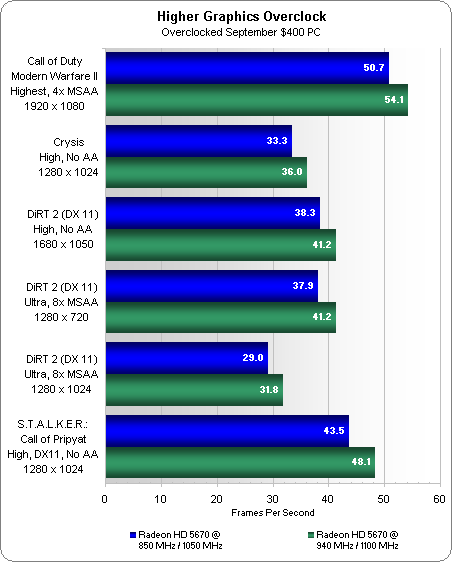System Builder Marathon, Sept. 2010: $400 Gaming PC
Maximizing Graphics Potential
We disabled DirectX 11 in DiRT 2 and switched to a lower 720p resolution, hoping to expose more reasonable settings for our Radeon HD 5670. But I still wanted to probe into the performance we left on the table by using AMD's Catalyst Control Center to overclock instead of MSI's Afterburner utility.
Here, we specifically concentrate on the point at which our more conservative overclock falls short on 3D power.
In Modern Warfare II, the overclocked $400 PC already delivers decent 1080p performance at our maximum test settings. An additional 7% performance boost isn’t too significant beyond increasing the machine's overall gaming value versus other machines.
High details in Crysis were playable at 720p, but our lowest official SBM resolution was beyond the system’s capabilities. The 8% boost isn’t shabby, but framerates are still below what we consider playable throughout the whole game.
DiRT 2 warrants more than one view. At high details without AA, the 8% performance boost seen at 1680x1050 could certain aid in smoother gaming. Cranking up to Ultra details with 8x AA, a 9% boost makes for an even better maxed-out 720p experience. The 10% boost at our lowest official SBM resolution of 1280x1024, however, still falls short of our desired target.
Lastly, an 11% increase in S.T.A.L.K.E.R.: Call of Pripyat (or more specifically, 12.5% in the Sun Shafts test), provides just the performance boost needed to call our lowest official test playable.
In all, our Radeon HD 5670 had 10% more performance or so still untapped, meaning that the decision not to use a third party overclocking utility during official benchmarks handicapped the potential performance gain over stock settings by roughly half. This could impact how the overclocked $400 PC stacks up to against the higher-priced builds. What is clear, though, is that even our maxed-out Radeon HD 5670 is still unable to stand up to the demanding SBM gaming suite.
Get Tom's Hardware's best news and in-depth reviews, straight to your inbox.
Current page: Maximizing Graphics Potential
Prev Page Benchmark Results: DiRT 2 And S.T.A.L.K.E.R.: Call Of Pripyat Next Page Power Consumption And Temperatures-
SpadeM ReplyGiven the motherboard’s basic passive cooling measures, though, there was really no point in putting more time into lowering the CPU multiplier, pushing a high reference clock, and attempting to maximize northbridge and memory frequencies.
+1 for making this statement, glad someone considered it at least. All in all decent build for the money. -
AMW1011 I'll be honest, I think a $450 budget is a little more reasonable than a $400 budget. At that price a 5750 or even a 5770 can be had, which would have worked fine with all of the other parts and likely would have matched the $550 June build.Reply
Even this $400 build packs a punch, you can get one HELL of a rig for the money any more. It really is insane, and that's not even considering the used or refurb market!
Awesome article, probably one of my favorite SBM, atleast the best I've seen in a long time. -
micr0be very nice build, interesting to see how much performance can be squeezed out of the budget. i was expecting worse results.Reply -
Gamer-girl ReplyIt went $1 over-budget if we substituted in a GeForce 9800 GT.
I doubt someone spending $400 can't afford to add an extra dollar. although i realize that the point in these articles is to stay under the budget, it would have been interesting to see the price/perforamce difference. -
haplo602 nice case, looks very good ... pity that rosewill does not have a downloadable manual for it ...Reply -
HibyPrime I'd be interested to know how much more overclocking headroom you could pull out of it if you left it at 3 cores - and would that net you more performance in most of the benchmarks?Reply
I'd bet if you could pull ~200 mhz more out of it, it would begin to match up with the missing core, and maybe start to pull away around 400mhz. -
Proximon The Cooler Master Elite 460 is a falsely labeled piece of crap. You can find the review (with proper testing) here: http://www.hardwaresecrets.com/article/1005/1Reply
You'll have to spend a little bit more there. Rosewill has a 430W (RG430 S12) unit or the Antec Neo 400W is almost the same price as the CM after a discount and rebate.

